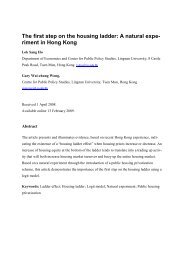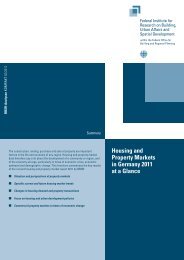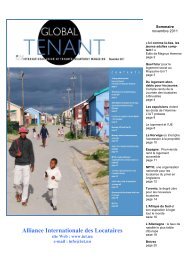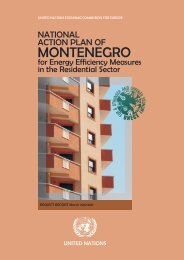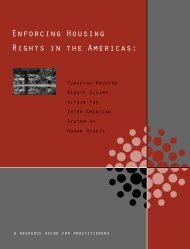housing developments in european countries - Department of ...
housing developments in european countries - Department of ...
housing developments in european countries - Department of ...
You also want an ePaper? Increase the reach of your titles
YUMPU automatically turns print PDFs into web optimized ePapers that Google loves.
Section 4<br />
Outcomes<br />
Outcomes Section 4<br />
Table<br />
4.7.5 Regional Variations <strong>in</strong> House Prices In European Countries<br />
Country Category Region Price<br />
Belgium Average sale price <strong>of</strong> owner occupied dwell<strong>in</strong>gs (€ million) 2002 Brussels Capital 130,756<br />
Flanders 95,770<br />
Wallonia 74,191<br />
Czech Republic Average purchase price per m 2 <strong>of</strong> dwell<strong>in</strong>g (CZK) 2002 Nationwide 7,663<br />
Prague 24,150<br />
F<strong>in</strong>land Average sale price per m 2 for apartments, 2003 (€) Hels<strong>in</strong>ki metropolitan area 2,309<br />
outside the Hels<strong>in</strong>ki metropolitan area 1,118<br />
Germany Average sale price per m 2 for owner occupied apartments, 2003 (€) Regions <strong>in</strong> the former Federal Republic <strong>of</strong> Germany 2,076<br />
Regions <strong>in</strong> the former Germany Democratic Republic 1,400<br />
and<br />
1,500<br />
Ireland Average sale price <strong>of</strong> second hand dwell<strong>in</strong>gs, 2003 (€) Whole country 264,898<br />
Dubl<strong>in</strong> 355,451<br />
Italy Average weighted prices per m 2 , 2003 (€) City centres 2,260<br />
City suburbs 1,190<br />
Small towns<br />
Spa<strong>in</strong> Average sale price <strong>of</strong> dwell<strong>in</strong>gs per m 2 2002 (€) National average 1.220.9<br />
Madrid region 2,001.6<br />
Barcelona region 1,838<br />
Note: Data for the follow<strong>in</strong>g <strong>countries</strong> are not available: Austria, Bulgaria, Cyprus, Denmark, Estonia, France, Greece, Hungary, Latvia, Lithuania, Luxembourg, Malta, Netherlands,<br />
Poland, Portugal, Romania, Slovakia, Slovenia, Sweden, Turkey United K<strong>in</strong>gdom.<br />
prices <strong>in</strong> Sweden <strong>in</strong>creased by just 10 po<strong>in</strong>ts between<br />
1999 and 2002.<br />
House price <strong>in</strong>flation did not impact evenly on all<br />
sectors <strong>of</strong> the <strong>hous<strong>in</strong>g</strong> market <strong>in</strong> these <strong>countries</strong>, but<br />
varied on a regional basis. As would be expected, <strong>in</strong><br />
most European <strong>countries</strong> residential property prices are<br />
significantly higher <strong>in</strong> cities than <strong>in</strong> rural areas. In<br />
addition, prices vary significantly between the west and<br />
the east <strong>of</strong> Germany. The available <strong>in</strong>formation on this<br />
issue is summarised <strong>in</strong> TABLE 4.7.5.<br />
4.7.4 Rents<br />
Information on trends <strong>in</strong> residential rents are available<br />
for only a m<strong>in</strong>ority <strong>of</strong> the <strong>countries</strong> exam<strong>in</strong>ed <strong>in</strong> this<br />
review. In particular, relatively few <strong>of</strong> the new EU<br />
member States and applicant <strong>countries</strong> collect data on<br />
rents. The <strong>countries</strong> for which data on rent <strong>in</strong>flation<br />
are available fall <strong>in</strong>to two dist<strong>in</strong>ct categories: those<br />
where rents have <strong>in</strong>creased significantly <strong>in</strong> recent years<br />
and those where rent <strong>in</strong>flation is moderate at the<br />
current time.<br />
Particularly detailed data on regional variations <strong>in</strong><br />
rents are available for Austria. These data clearly<br />
<strong>in</strong>dicate that Austria is <strong>in</strong> the low rent category. Rents<br />
countrywide <strong>in</strong>creased by 1.7% between the beg<strong>in</strong>n<strong>in</strong>g<br />
<strong>of</strong> April 2001 and the end <strong>of</strong> March 2002, which is<br />
less than the general rate <strong>of</strong> price <strong>in</strong>flation. Dur<strong>in</strong>g this<br />
period Burgenland was the region with the highest rate<br />
<strong>of</strong> price <strong>in</strong>flation, as rents here <strong>in</strong>creased by 2.1%.<br />
The available <strong>in</strong>formation <strong>in</strong>dicates that the majority<br />
<strong>of</strong> European <strong>countries</strong> also fall <strong>in</strong>to this moderate rent<br />
<strong>in</strong>flation category. For <strong>in</strong>stance, <strong>in</strong> Ireland the rate <strong>of</strong><br />
<strong>in</strong>crease <strong>in</strong> private sector rents had fallen <strong>in</strong> recent<br />
years and <strong>in</strong> F<strong>in</strong>land rents have <strong>in</strong>creased between 3%<br />
and 4% annually <strong>in</strong> recent years. The average rent <strong>in</strong><br />
the free market sector <strong>in</strong> this country is currently €8.5<br />
per m 2 per month (€11.26 per m 2 per month <strong>in</strong> the<br />
Hels<strong>in</strong>ki metropolitan area and €7.57 per m 2 per<br />
month <strong>in</strong> the rest <strong>of</strong> the country) and <strong>in</strong> the social<br />
<strong>hous<strong>in</strong>g</strong> sector it is €7.16 per m 2 per month (€8.13 per<br />
m 2 per month <strong>in</strong> the Hels<strong>in</strong>ki metropolitan area and<br />
€6.8 per m 2 per month elsewhere). The pace <strong>of</strong> rent<br />
<strong>in</strong>flation <strong>in</strong> both the private and the social rented<br />
sectors <strong>in</strong> France has also slowed considerably <strong>in</strong><br />
recent years. Rents <strong>in</strong> this country grew by 6.7% <strong>in</strong> the<br />
private sector, and by 6.2% <strong>in</strong> the social sector<br />
between 1985 and 1986. Rent <strong>in</strong>flation then fell<br />
steadily over the follow<strong>in</strong>g decade, reach<strong>in</strong>g a low <strong>of</strong><br />
1.2% <strong>in</strong> the social sector and 1.4% <strong>in</strong> the private<br />
sector <strong>in</strong> 1999/2000. This decl<strong>in</strong>e reversed somewhat<br />
between 2002 and 2003, as dur<strong>in</strong>g this period rents<br />
<strong>in</strong>creased by 3.3% <strong>in</strong> the private sector and 2.9% <strong>in</strong><br />
the social sector. As would be expected <strong>in</strong> view <strong>of</strong> the<br />
fall<strong>in</strong>g demand for rented <strong>hous<strong>in</strong>g</strong> <strong>in</strong> Germany, rents <strong>in</strong><br />
this country have been <strong>in</strong>creas<strong>in</strong>g only moderately <strong>in</strong><br />
recent years and <strong>in</strong> some areas have decreased slightly.<br />
The pr<strong>in</strong>cipal exceptions to this trend are the<br />
expand<strong>in</strong>g cities <strong>in</strong> the west <strong>of</strong> the country such as:<br />
Munich, Frankfurt and Cologne. At the same time, like<br />
most other aspects <strong>of</strong> the German <strong>hous<strong>in</strong>g</strong> market,<br />
rents vary between the regions located <strong>in</strong> the former<br />
German Democratic Republic and the rest <strong>of</strong> the<br />
country. Data collected <strong>in</strong> April 2002 found that the<br />
‘gross cold rent’ per m 2 (net rent plus runn<strong>in</strong>g costs but<br />
exclud<strong>in</strong>g heat<strong>in</strong>g and hot water costs) paid by<br />
households <strong>in</strong> the former GDR region was €5.29,<br />
which is 88% <strong>of</strong> the equivalent figure for rest <strong>of</strong> the<br />
country. Gross cold rent for the country as a whole<br />
was approximately €5.93 per m 2 at this time.<br />
Greece saw very significant rent <strong>in</strong>flation <strong>in</strong> the early<br />
1990s. The real price <strong>in</strong>dex (adjusted for <strong>in</strong>flation)<br />
<strong>in</strong>dicates that rents <strong>in</strong> urban areas grew by 23.2%<br />
between 1990 to 1994. However, fall<strong>in</strong>g demand<br />
reduced the pace <strong>of</strong> rent <strong>in</strong>flation <strong>in</strong> the mid to late<br />
1990s, and as a result urban rents grew by 36% <strong>in</strong> real<br />
terms between 1990 and 2000. In Spa<strong>in</strong>, rents grew by<br />
4.25% between 2000 and 2001 and by 4.36%<br />
between 2001 and 2002. Similarly <strong>in</strong> the Netherlands,<br />
social rents grew by 7% and private rents grew by 5%<br />
between 2000 and 2002, while house price <strong>in</strong>flation<br />
dur<strong>in</strong>g the same period was 13%.<br />
In a m<strong>in</strong>ority <strong>of</strong> European <strong>countries</strong> rents have<br />
<strong>in</strong>creased at a much more substantial pace <strong>in</strong> recent<br />
years. In Belgium, for <strong>in</strong>stance, between 1999 and<br />
2002, the <strong>in</strong>dex <strong>of</strong> consumer prices <strong>in</strong> this country rose<br />
by 25% while the rent <strong>in</strong>dex rose by 38%. Data from<br />
the Czech Statistical Office <strong>in</strong>dicate that between<br />
December 1999 and January 2004 regulated rent<br />
<strong>in</strong>creased by approximately 18%. Despite the fact that<br />
<strong>in</strong> Italy the number <strong>of</strong> families who live <strong>in</strong> rented<br />
accommodation cont<strong>in</strong>ues to decrease, the amount<br />
paid <strong>in</strong> rent has risen to €279 per month. In Latvia<br />
apartment rents have also <strong>in</strong>creased significantly<br />
dur<strong>in</strong>g the 1990s – from an average <strong>of</strong> US$12.7 per<br />
month <strong>in</strong> 1993 to US$27.4 per month <strong>in</strong> 2001. Rents<br />
<strong>in</strong> Sweden have <strong>in</strong>creased at a much faster pace than<br />
house prices over the last decade. Between 1990 and<br />
2002 the <strong>in</strong>dex <strong>of</strong> rents <strong>in</strong>creased by 83 po<strong>in</strong>ts, while<br />
the house price <strong>in</strong>dex <strong>in</strong>creased by only 49 po<strong>in</strong>ts over<br />
the same period, which is likely related to the low<br />
output <strong>of</strong> <strong>hous<strong>in</strong>g</strong> for rent. In the UK the average rent<br />
has <strong>in</strong>creased from STG£40 per week <strong>in</strong> 1990, to<br />
STG£79 per week <strong>in</strong> 1997/1998 to STG£110 per week<br />
<strong>in</strong> 2002/2003.<br />
In the case <strong>of</strong> a number <strong>of</strong> other <strong>countries</strong>, data on<br />
rents are only available for a s<strong>in</strong>gle year, although<br />
these data reveal some <strong>in</strong>terest<strong>in</strong>g variations <strong>in</strong> the<br />
rents paid <strong>in</strong> different segments <strong>of</strong> the <strong>hous<strong>in</strong>g</strong> market<br />
and sections <strong>of</strong> the population. In the case <strong>of</strong><br />
Luxembourg, for <strong>in</strong>stance, <strong>in</strong> 2001 the average<br />
monthly rent was €475, or €4.80 per m 2 , which<br />
constitutes 22% <strong>of</strong> household <strong>in</strong>come on average. In<br />
the same year average rent paid for houses <strong>in</strong> this<br />
country was €490 or 4.50 per m 2 per month, which is<br />
slightly higher than the average monthly apartment<br />
rent <strong>of</strong> €448 or €4.50 per m 2 . In Malta 51.35% <strong>of</strong> the<br />
population paid between 1 and 50 MTL <strong>in</strong> rent per<br />
month <strong>in</strong> 1995, while a further 28.63% paid between<br />
51 and 100 MTL and only 5.23% paid more than 300<br />
MTL. These very low average rents reflect the high<br />
proportion <strong>of</strong> rent-controlled dwell<strong>in</strong>gs <strong>in</strong> the Maltese<br />
<strong>hous<strong>in</strong>g</strong> market. Data collected <strong>in</strong> the third quarter <strong>of</strong><br />
2000 <strong>in</strong>dicate that the average rent <strong>in</strong> Slovakia was<br />
114 SKK per month, which constitutes only 1.6% <strong>of</strong><br />
the average <strong>in</strong>come dur<strong>in</strong>g the same period. This<br />
phenomenon is due to the relatively low proportion <strong>of</strong><br />
unregulated private sector tenancies <strong>in</strong> the Slovakian<br />
<strong>hous<strong>in</strong>g</strong> market.<br />
160 European Union Report<br />
Regular National Report on Hous<strong>in</strong>g Developments <strong>in</strong> European Countries<br />
161





